Flea drops for kittens
Flea remedies for kittens must be selected with special care, because many of them can have an extremely negative effect not only on parasites, but also on the pets themselves.
When choosing flea drops for kittens, you need to focus on the age of the kids. In the first months of life, kittens still have too weak an immune system. Drops, which contain highly toxic substances, can cause much more harm to a pet’s health than fleas, and even lead to its death.
That is why it is advisable to use such drugs to treat a pet only after it reaches 2–3 months of age.
If the baby is breastfed, before flea treatment you need to assess the degree of its infestation. Cats lick their kittens, and this helps them to some extent get rid of parasites. However, it is precisely because of regular licking that all substances applied to the baby’s fur will inevitably end up first in the cat’s gastrointestinal tract, and then through the milk and to the kitten.
For this reason, if the number of parasites is small, it is better to rid the kitten of fleas when breastfeeding is completed.
Important! Owners should remember that it is strictly prohibited to remove fleas using insecticidal preparations for sick and weakened kittens.
Other means
Fleas can also be removed with tablets (for example, Comfortis) and with injections (Ivermec) or powders (Zecken Und Flohpuder). But such treatment is effective only with additional disinfection of the home where the cat lives.
Shampoos
They can be used when the animal is already infected. The pet must be thoroughly soaped, soaking the entire fur with foam, avoiding contact with the eyes and ears, leave for ten minutes, after which the shampoo should be rinsed off well.
The most popular products: Rolf Club, Fitoelita, Biovax, Mr. Kiss, "Bio Groom" . All shampoos have approximately the same effect. It is important to choose the right product. Be careful: after treatment, the cat will lick itself and may receive a small dose of the drug.
Sprays
Available in the form of aerosols and cans. An effective flea repellent. True, not all cats like the sound of spraying; they may be frightened by it. The pet should be treated completely, but make sure that the spray does not get into the eyes, ears or mucous membranes.
In this case, the head must be treated: for example, with a cotton swab soaked in spray. The most popular products: Hartz (valid for 7 days), Bars, Frontline (valid for up to a month).
Flea collars
The validity period of a flea collar is from 4 to 7 months, depending on the manufacturer. When choosing, special attention should be paid to the composition of the material from which the collar is made: substances such as amitraz, organophosphates and permethrin are very dangerous for cats.
In addition, you must carefully ensure that the collar does not cause an allergic reaction or irritate the skin. The most popular manufacturers: Hartz, Bolfo, “Clandestine”.
To get rid of parasites in a short time, your pet must be shown to a veterinarian, who will select the appropriate remedy.
Sources:
https://petstory.ru/knowledge/cats/cat-health/cat-prevention/sredstva-ot-blokh/
https://vetzverocenter.ru/preparaty-ot-bloh-dlya-koshek/
Where can a kitten get fleas?
Unfortunately, fleas appear on kittens quite often. And not only among street kids, but also among domestic kittens.
Female fleas throw out fertilized eggs over fairly long distances as they move. They roll off the cat's fur and accumulate in the corners of the apartment. Subsequently, larvae emerge from the eggs, and then pupae, which are ready to wait for their prey for months, even under unfavorable conditions.
There are several ways kittens can become infected with fleas:
- Other animals. Babies can become infected with external parasites not only from their mother, but also from other pets who live in the house and have free access to the outside.
- Human. Fleas in newborn kittens can appear after direct contact with the owner's outdoor clothing or shoes.
- Rodents. Sometimes kittens pick up fleas after hunting mice or other rodents.
- Street. If kids have the opportunity to go outside, they are almost 100% likely to become infected with fleas.
Fleas cause serious damage to the health of animals. That is why owners need to identify symptoms of infection as soon as possible and take measures to rid the kitten of fleas.
How can you get infected?
Most often, parasite infection occurs outdoors. Flea eggs remain in places where an infected animal has visited. A larva develops from them, pupates, and a flea hatches. She quickly finds a suitable host, and once in the house she begins to actively reproduce.
Cats that do not go outside are also not protected from encountering parasites. A person can bring them from the street or from the entrance using his shoes and clothes.
Kittens most often become infected from their mother cat. But another animal living in the house can bring parasites to babies. Even the owner himself is on the soles of his shoes.
The reproduction rate of fleas is quite high. It is also worth considering that only about 20% of parasites are found on the animal’s body. The remaining 80%, in the form of eggs, larvae or pupae, live in cracks, baseboards, carpets, cat litter, etc.
How to detect parasites
Fleas in kittens can only be detected with careful examination or if there are too many parasites, but outwardly the baby may look quite healthy.
Characteristic signs of a kitten being infected with fleas:
- The pet often itches, and he begins to do it very sharply.
- Flea excrement in the form of small black particles or flea eggs can be found on the neck, ears and stomach.
- Non-healing wounds and scratches appear on the animal’s skin.
- The baby is inactive, weak, eats poorly, and loses weight.
- Your pet's fur is falling out.
- The pet sleeps very restlessly.
Important! In particularly advanced conditions, the baby may develop dermatitis, dermatophiliasis and other ulcerative skin lesions.
How does infection occur?
There are several ways to infect a kitten with fleas. First of all, they can get on it from the mother cat. In addition, there are the following ways:
- on a walk;
- with the owner’s shoes or clothes;
- from other infected animals.
Even the smallest kitten can become infected with fleas. It is important to promptly examine your pet and, if parasites are identified, begin to destroy them as early as possible.
Important! If your animal is itching and you can't see fleas, be sure to show it to a specialist. Itching can be a consequence of other diseases.
A large number of products are produced today to eliminate fleas. But you need to know that removing fleas from kittens is not so easy. It is important not to buy the first drug you come across and adhere to all safety measures.
Is it necessary to treat
It happens that the owner does not pay attention to the fact that his pets are infected with fleas, believing that this is the norm for animals that spend a lot of time outside. But these parasites can cause many problems not only for cats, but also for owners.
Fleas can carry many diseases dangerous to humans, such as typhus, anthrax, and pseudotuberculosis. They are also carriers of helminth eggs.
A flea bite causes severe itching for both the cat and the owner. When scratching the bite site, wounds and ulcers may appear. An allergic reaction to flea saliva may occur in the form of redness, rash, and swelling. Cats begin to lose hair. At the same time, debilitating parasite bites can become deadly for small kittens.
How to get rid of parasites: description of remedies
When choosing a drug, consider the age of the kitten and the individual characteristics of its body. It would be a good idea to consult a veterinarian. A note stating that the drug is suitable for kittens should be on its packaging. Flea control products come in a variety of forms.
For small kittens under 2 months of age, you can only use the following shampoos:
- "Doctor ZOO" is a product based on herbal ingredients.
- "Gamma for kittens."
- "Cleanin for puppies and kittens."
If the insect infestation is more severe and the kitten is over two months old, in addition to shampoos, the following can be used:
- drops;
- aerosols;
- insecticidal solutions;
- anti-flea collars.
Aerosols must be sprayed from a can so that the animal’s fur is evenly moistened. The following products from this group can be used for kittens:
- "Bars Forte" - for kittens from 10 weeks.
- “Bolfo” – from 6 weeks.
- “BlochNet” – for animals from 12 weeks.
There are liquid products available to combat parasites. Usually these are emulsions and insecticides in ampoules, which are diluted with water and evenly distributed over the animal’s fur, then you need to let them dry.
Aminat emulsion is suitable for kittens. It can be used to remove fleas from animals 2 months and older.
Other liquid preparations, such as Butox, Neostomazan and others, are not suitable for animals under six months old.
Flea drops are insecticides in plastic pipettes. The pipette needs to be opened and its contents squeezed out along the spine onto the skin, where the cat cannot reach while washing.
Popular drugs have age restrictions:
- "Bars" is intended for animals from 10 weeks.
- “Dana” – also from 10 weeks.
- “Frontline” – from 8 weeks.
- “Greenfort Biodrops” – for kittens from 4 weeks.
- “Clandestine for puppies and kittens” – for animals older than 10 weeks.
- “Stronghold for kittens and puppies” – over 8 weeks.
Collars do not help kill insects, but prevent re-infestation. Most are designed for cats 6 months and older, but some manufacturers offer collars specifically for kittens 2 to 6 months:
- “Rolf Club” – from 2 months.
- “BioVax” – from 8 weeks.
- “Delix” – from 8 weeks.
- “Clandestine Junior” and “Clandestine Maximum” – from 8 weeks.
- Beaphar SOS – from 6 weeks.
There are a number of folk remedies. They can complement the main therapy. Here is one of the popular folk recipes:
- Mix a tablespoon of salt in a glass of water.
- Bathe the kitten in the saline solution for 10 minutes.
- Wipe and dry the animal, while combing out harmful insects.
We invite you to watch a video about a folk method of removing fleas from kittens using tar soap:
Effective drugs
The product is sold in a veterinary pharmacy. The price category is different. Which drops are better depends on the age of the pet, its state of health, and the personal preferences of the owner. The best flea remedy, according to buyers, does not cause an allergic reaction, is well tolerated, copes with parasites, and protects against re-infection. There are several of these in the ranking of the best.
Beaphar
It is allowed to treat kittens, pregnant cats, and weakened animals. The active components do not cause harm, even if the cat licks the kittens after treatment.
Review
I treat my pets regularly. Valid for about a month. In the first days, my cat becomes sleepy and tears flow. The next day everything is fine. I have been using it for more than 2 years.
Anna, Moscow
Flea drops for cats
Leopard
Domestic products. The medicine is produced in ampoules. The active substance is the modern insecticide fipronil. It is forbidden to use Bars drops to pregnant or lactating females. A safe, less concentrated product is available for kittens. It is allowed to process young animals from 10 weeks. The specific dosage for the animal is selected depending on its weight.
Review
The best remedy in my opinion. It is inexpensive and sold in every pharmacy. It helps quickly, the action lasts for 2 months. During the entire warm season you have to treat the cat only twice.
Elena, St. Petersburg
Barrier-Super
Convenient packaging. Validity up to 2 months. Contraindications are standard. A powerful remedy kills parasites in a few minutes. Allowed for use by kittens from 3 months of age. They only drip onto the withers, observing all safety measures.
Review
Handled kittens. There were tears, saliva flowed. The next day it became normal. Helps against fleas. It itches a little where applied.
Olga, Moscow
Advantage
Drops to protect your pet from parasites
Flea drops for kittens are used from 8 weeks. Allowed for use by pregnant and lactating women. The effect lasts for about a month. Has virtually no side effects. Convenient dropper. Advantage should be applied in one place - at the withers, or along the spine.
Review
The best drug. It suited my cat. No side effects. I use it during pregnancy. Convenient dropper. Can be used against fleas in kittens from one month of age. And also to dogs.
Inna, Tver
Features of flea removal in kittens
How to remove fleas from a kitten at home depends on the age of the baby and the number of insects. Up to 3-4 months, kittens have a very weak immune system; the use of chemicals can cause more harm to the pet’s health than the presence of parasites. Therefore, sometimes it is worth holding off on removal, especially if there are very few insects on the fur.
Only home methods are suitable for treating newborn kittens under one month of age. From 2-3 months, some chemicals can be used.
If the baby has not yet been weaned from its mother, all substances applied to its fur will enter the digestive system of the cat, and then the kitten during feeding through milk.
The use of insecticidal preparations based on poisons is permissible in kittens only after reaching 6 months of age. They are applied exclusively to the withers - a place that the pet cannot reach when licking the fur.
It is believed that a cat can rid a kitten of fleas while licking, but no matter how much she chases parasites through the baby’s fur, she cannot cope with this scourge without your help.
For the flea removal process to be effective, it is necessary to treat all cats in the house at the same time. It is advisable to carry out a general cleaning and eradicate insects in carpets, upholstered furniture, along baseboards and in pets’ sleeping areas.
Please note that the use of some products is permissible only after a certain period of time after vaccination of the animal. Strong drugs should also not be used if your pet is sick.
Which drops to choose: Russian production
There are many flea medications available on the market from different manufacturers. The veterinarian will help you choose the most suitable one according to the animal’s age, living conditions, and degree of infection.
Today, Bars anti-flea drops for kittens have gained the most popularity. The drug is produced in Russia and has a low cost. It contains the least toxic insecticide fipronil, as well as diflubenzurol. It has a long-lasting effect: one application lasts up to two months against fleas and about a month against ticks. Has repellent properties.
Apply “Bars” to dry skin at several points on the back that are inaccessible to the kitten, between the shoulder blades or at the base of the neck. The required amount of the drug is calculated based on the weight of the animal.
You cannot treat babies under 10 weeks of age, as well as those with various diseases or those recovering from an illness.
Another well-known drug is Celandine anti-flea drops for kittens. Also made in Russia. The basis of this product is not the plant of the same name, but a combination of two insecticides: fipronil and permethrin. Can be used for babies starting from two months of age. Its protection lasts for two months against fleas, up to one month against ticks. The dosage, as with analogues, depends on how much the animal weighs.
Ways to combat parasites in kittens of different ages
Every owner wants to free his ward from uninvited guests as efficiently and carefully as possible. There are different ways to control fleas:
- mechanically clean - bathe and remove fleas manually or by combing; You can remove fleas from a kitten by combing
- wash the kitten with antiparasitic shampoo;
- apply other antiparasitic agents;
- choose gentle folk recipes.
Depending on the age of your pet, you must carefully choose the appropriate parasite control product.
In kittens up to 1 month
At the age of up to 1 month, the kitten is not yet ready for potent drugs; its immunity is weak and susceptible to infections and diseases. Therefore, our recommendation would be to postpone the fight against bloodsuckers until the age of 3-4 months, if there are still few fleas. Only if the animal is constantly itching and tearing the skin with its claws can mechanical treatment begin:
- Wash the old bedding and put on a new one.
- Vacuum and wash the area where the kitten lives.
- Comb out parasites with a fine-toothed comb. Parasites on a kitten should be combed out with a fine-toothed comb.
Try to do these manipulations as often as possible - preferably every day. Such procedures will alleviate the kitten’s condition and delay the use of antiparasitic drugs.
In kittens up to two months
If the kitten’s condition is deplorable, and you can’t wait to help your pet, find flea shampoo for kittens up to two months on sale.
Shampoo should not be used for humans due to the difference in the alkaline balance of the skin between humans and cats.
You need to wash your kitten with flea shampoo as follows:
- Start by trimming your pet's nails, otherwise your hands could get pretty damaged.
- Check that there are no drafts and that the house is warm. Cats get very cold after bathing.
- Then prepare the necessary tools: a basin (bath), shampoo, a comb for combing and a towel.
- Hold the kitten and, gently talking and stroking it, place it in a bowl of warm water (38–42 °C).
- Begin to calmly and confidently wash the kitten from head to toe. To prevent water from getting into your ears, carefully insert cotton swabs into them, and apply a drop of Vaseline to the teardrops of your eyes with a cotton swab.
- As soon as the fur is wet, apply the diluted shampoo to the kitten's body and paws, lather thoroughly and hold for 7-8 minutes. To remove fleas, apply shampoo to the kitten's fur and leave for 7-8 minutes.
- Then rinse the kitten under running water. Please note that rinsing off shampoo is a thorough and mandatory process. Rinse for 5-7 minutes, otherwise the shampoo may not be washed out, and the animal will be poisoned when licking it from the fur. After washing, you need to thoroughly rinse the shampoo from the kitten’s fur so that the animal does not get poisoned when licking it.
- Immediately after rinsing the shampoo, place your pet in a towel; he will begin to tremble; it is important to wrap and warm the baby.
- You can start combing out fleas with a comb right in the towel. They are clearly visible in wet wool.
- Wipe, dry, caress the kitten - it has gone through a lot of stress.
In kittens after 2–3 months
Your pet has grown up, and the arsenal of means to combat bloodsuckers has grown. Now you can use drops on the withers, a collar for prevention, flea sprays or folk recipes for removing parasites from a kitten’s fur.
Review of popular flea drops - application, indications and contraindications
To understand which flea drops to choose, it makes sense to analyze the best ones.
Inspector
This drug will help cure a kitten from fleas, ticks, and lice. The number of drops depends on the actual weight of the animal and is determined according to the table given in the instructions.
A contraindication for use is individual intolerance to the components of the drug.
Important! Kittens weighing less than 1 kg and under 7 months of age should not use the product.
Celandine
The drug is recommended for cats and kittens who are already 2 months old. Apply to dry skin at the withers and between the shoulder blades. One pipette with medicine is designed for a cat weighing 2-10 kg.
Drops Celandine
The drug should not be used in kittens under 8 weeks of age if they have an allergic reaction to its components or with a weakened immune system.
Beaphar
This is a clear, thick solution without foreign matter, with a slight odor and the active ingredient diazinon. The principle of action is based on damage to the locomotor system of fleas, through paralysis, which leads to their death within 24 hours. Additional components included in the complex penetrate into the deep layers of the skin, exhibiting antimicrobial and regenerating activity.
Hartz
An insecticidal agent designed to quickly destroy ectoparasites and prevent their reappearance within a month. The effect is provided by the active component methoprene. After application, it accumulates in the sebaceous glands and dermis of the animal, providing a contact insecto-acaricidal effect.
Inspector
“Inspector” is an anti-flea agent, the active composition of which is fipronil and moxidetin. They are able to quickly distribute on the surface of the pet’s body, accumulating in the dermis and not being absorbed into the blood. Thanks to this complex universal effect, effective protection against parasites is noted, which eliminates re-infection for up to one and a half months.
RolfClub 3D
This is a clear, thick, amber-colored liquid containing fipronil, etofenprox, and pyriproxyfen. The mechanism of action of the insecticide is to block innervation. This leads to impaired coordination of movements, paralysis and death of parasites that occur upon first contact with the animal’s fur.
Stronghold
"Stronghold" is an insecticide in the form of a clear solution with selamectin. It is characterized by a wide spectrum of action. The product has a paralyzing effect on ticks and helminths. To kill fleas and prevent re-infection, the drug is used once a month.
Advantage
With the help of these drops it will be possible to rid cats and kittens of lice, fleas and lice. The product should be applied to the withers, the dosage is determined by the weight of the pet. The result comes within 12 hours. The drug can be used to treat domestic kittens at any age. It is also allowed for pregnant and lactating cats. There are no contraindications.
"Bolfo-aerosol"
A solution for external use in the form of an aerosol with the active ingredient propoxur. Before using the drug, its contents are shaken, then the spray is sprayed. The product is ideal for treating bedding, beds, houses, and hammocks for cats.
"VetExpert Pro Insecta"
The action of the drug is based on the properties of the active ingredients thiamethoxam, pyriproxyfen and cyfluthrin. In combination, they disrupt the functioning of all insect life systems. This causes paralysis and death of fleas.
"Dana"
The main composition of the veterinary drug is represented exclusively by fipronil. The disinfecting effect of the product appears within a day and continues for one and a half months after one treatment of the cat. It is relatively safe, and side effects are rare in clinical practice.
"Prasicide-complex"
This is the name of antiparasitic drops for external use with praziquantel, ivermectin, levamisole, fipronil. Additional ingredients ensure their good absorption at the site of application and long-term presence in the highest possible concentration in the body. One-time use of drops guarantees protection for about a month.
"Frontline"
A thick, viscous solution of “Frontline” with fipronil is a quick, effective, convenient way to get rid of fleas. It is used monthly, since the active substance destroys all fleas for exactly this period. The result of using the product is observed for a month and a half, but the likelihood of re-infection appears after 30 days.
Agrovet protection 4 with tail
Drops for the prevention of cat diseases caused by blood-sucking insects. The composition of the drug, as in the previous case, is absolutely natural. Essential oils from plants will ward off parasites. Moreover, the repulsive properties will last from 3 to 8 weeks. For a weight of 1 to 3 kg, you need to use 10 drops once, 1 pipette is intended for 3-8 kg, if the animal weighs more than 8 kg, take 2 pipettes. Contraindications include age younger than 8 months, nursing females, and hypersensitivity to essential oils.
Advantages
- Safe composition;
- Long lasting effect;
- Minimal toxicity;
- Activity towards various insects;
- Nice smell;
- Inexpensive.
Flaws
- Effective for a short period of time;
- Not suitable for everyone.
These are one of the most common inexpensive drops for the safe treatment of animals and the prevention of re-infections. But not every four-legged friend is suitable for this composition; some are allergic to esters. Over a hundred reviews are positive; buyers approve of the smell, ease of use, and lack of synthetic components.
Lawyer (Bayer)
To reliably protect your furry four-legged friends, Bayer offers highly effective flea and worm drops for cats – Advocate. They also demonstrate activity against various mites and lice. This is a combined antiparasitic drug based on the insecticides imidacloprid and moxidectin. The viscous, thick solution is presented in two doses - for kittens and adults. The poisons accumulate evenly in the soft tissues, after which the insects will bite the cat and die quite quickly. The procedure must be repeated after 3-4 months to prevent re-infections. Allowed for use during pregnancy and breastfeeding.
Advantages
- German production;
- Thoughtful combo composition;
- Separate dosage for kittens;
- Performance;
- Safety for pregnant and lactating females;
- Excellent tolerability.
Flaws
- Price;
- For a large cat you will need several pipettes.
Judging by the reviews, this is one of the best remedies against fleas in cats and dogs. It is actively used for worms, various ticks, and lice. Advocate has received the best recommendations from veterinarians and kennel owners. Buyers approve of the speed of action and good tolerability. The downside is the price, as well as the fact that a large cat will need several pipettes.
BioVax
The drug can be used to prevent or get rid of not only fleas, but also annoying mosquitoes or flies. The principle of operation is repellent, that is, repels insects. Release form – solution for external application, which penetrates into soft tissues and is evenly distributed over the dermis. The composition contains plant components of lavender, calendula, and Dalmatian chamomile. One dosage is intended for children, the other for adults. The validity period is 24 hours, after which the protective effect lasts up to 1 month. Age limit: kitten less than 4 weeks old. Treatment is contraindicated in case of infectious diseases.
Advantages
- Natural ingredients;
- Antifungal effect;
- Pleasant aroma;
- Good tolerance;
- Doses for kittens, adult animals;
- Inexpensive.
Flaws
- Oily coat;
- The effect lasts much less.
The manufacturer indicates in the instructions that drops with a natural composition help not only pets, but also improve indoor air with their antifungal and antiseptic effect. One ampoule is provided for a weight of 2 to 10 kg.
When applying, it is important that the solution does not spread, but is absorbed pointwise into the skin. Over 90% of reviews approve of the composition and results of the treatment, and only a few complain about the short-term protection and greasy coat.
Stronghold
Drops are prescribed to cats and kittens once from 6 weeks of age in the presence of fleas, ticks and helminths. The amount of product is calculated based on the weight of the animal, the effect occurs within 2 hours. Repeated use of the product will need to be done once a month.
Important! The product is non-toxic and has no contraindications.
Leopard
The drug is prescribed to remove fleas, lice and lice from the fur of a four-legged pet. It is used once in the form of drops, applied in the withers area, between the shoulder blades (in hard-to-reach places that cannot be licked off). The dosage depends on the weight of the animal and is determined according to the table located in the instructions.
Contraindications include intolerance to the components of the product, the presence of infectious diseases, age up to 8 months, weight up to 2 kg.
Beaphar
Drops are recommended for repelling fleas and other parasites, starting from 12 weeks of age in kittens. The product should be applied to the withers. The effect is observed for 1 month, after which the procedure will need to be repeated.
Important! Beafar should not be used by kittens with poor health and those pets that are in the recovery stage.
Pros and cons of using drops
In veterinary medicine, such a flea remedy as drops is common. Their advantages:
- ease of use;
- versatility - the drops additionally protect the cat from ticks, lice, lice and helminths;
- effectiveness - repeated prophylaxis should be carried out after 2-3 months (for each drug, the duration of action is indicated in the instructions).
Disadvantages of drops:
- most products are contraindicated in kittens under 12 weeks of age and pregnant cats;
- toxicity - at least 2-3 days must pass from the last bath of the animal until treatment with drops, so that a protective fat layer has time to form.
Applying drops to the cat's fur.
Operating principle
Drops from entomosis, falling on the surface of the skin, are immediately absorbed and begin to accumulate in the sebaceous glands. After this, the medicine is gradually released, providing protection against parasitic insects for a long period.
If the drops are not applied for prophylactic purposes, but on an already infected animal, then the fleas leave the cat’s body after a few minutes.
Components of drip preparations
The main components of drip preparations for cats:
- Invermectin. Destroys microorganisms.
- Permethrin. An insecticide that is safe for both animals and humans.
- Pyriproxyfen. Component used as a basis for antiparasitic drops.
- Fipronil. Prevents re-infection.
Due to these components, the room in which the animal lives is disinfected.
Basic rules for using drops
Flea drops for cats will only work effectively if they are used correctly. In this case, the following rules must be observed:
- Using drops at home is extremely simple. It is enough to spread the fur on your pet’s withers, drop a couple of drops and rub it with your fingers so that the liquid does not spread. The exact amount of product to be used is indicated in the instructions.
- After application, the product quickly begins to act. The cat should not be combed or washed for several days.
- Some medications are recommended to be applied to points along the entire length of the spine. This way the effect of the product will be stronger. But at the same time you will have to monitor whether the cat licks the product.
- Cases where flea drops on the withers for cats do not help are rare. This is only possible if, after applying them, the animal gets caught in heavy rain and the drug is washed off.
- When applying drops, you must be careful not to accidentally get them into your pet's eyes or nose. If this happens, rinse thoroughly with plenty of running water.
- If the drops are licked off, there is no need to worry. The amount of active substance is so small that it cannot harm the pet. But if you treated kittens for ticks and fleas, and the cat licked them, a negative reaction from her body is possible. Because of this, many drugs are prohibited for use on kittens under two months of age.
- You should only purchase anti-flea drops for cats in large, trusted stores. This is the only way you can be sure of their quality and safety.
Article on the topic: How to apply flea drops to a cat?
Traditional methods
You can get rid of fleas on a kitten at home without the use of special chemicals. This is especially true if the baby is less than 2 months old. Traditional methods are gentle and harmless, but sometimes tedious and not effective enough. But if you have no choice, it's worth trying them. How to remove fleas from a kitten using traditional methods: manually or using natural remedies.
Mechanical removal
By rights, the safest method of getting rid of fleas is mechanical, which allows you to remove insects even from newborn kittens. At the same time, it is the most labor-intensive and time-consuming, since it is not possible to quickly get rid of fleas by combing due to the presence of numerous clutches of eggs.
To carry out the procedure, you will need a hard plastic comb with frequent rounded teeth and a white sheet of paper. Combing fleas should begin from the back, gradually moving to the abdomen and paws. It is not recommended to manipulate the pet's head - you can injure the kitten's ears, nose and eyes. Any fleas on the paper should be immediately crushed or thrown into a container of water. The processing comb also needs to be periodically cleaned of accumulations of insects and hair.
You need to carry out the procedure twice a day until the fleas disappear. One combing session should take about 10 minutes on average. As a rule, it takes 1 month to solve the problem. Afterwards, it is necessary to check the fur for several weeks, since new individuals could emerge from the remaining eggs.
Bathing
Plain water will not get rid of fleas. But if you add salt, tansy or wormwood to the bath, the insects will begin to disappear.
Salt bath. Add table salt to warm water at the rate of 1 tbsp. 200 ml, dissolve. Place your pet in the solution for 10 minutes. Then pat the fur dry with a towel and comb out with a comb. Repeat the procedure every week.
A decoction of wormwood or tansy. Brew the chopped herb in boiling water (1 tablespoon per glass). Prepare a warm bath and pour in the infusion. Keep your pet in the solution for several minutes and dry the fur well. The procedure can be carried out several times a week.
Important! When bathing, be careful not to get water into your pet's ears, nose or eyes!
Tar soap
This flea remedy for kittens is completely safe and quite effective. The soap needs to be turned into thick foam. To make the process easier, you can grate the piece and dissolve it in warm water. The foam should be rubbed into the pet’s fur and rinsed off after a few minutes. To remove dead insects, you can comb the fur after drying.
Side effects
Flea drops are not highly toxic, and if you notice that your pet has licked a little of the drug, there is no need to worry. Nothing serious will happen. For prevention, you can rinse your tongue and mouth with running water. However, if you did not follow the rules of application, and the cat licked large quantities of flea drops, the following side effects may occur:
- itching;
- allergic reaction;
- shiver;
- weakness;
- refusal of food;
- vomit;
- weight loss;
- temperature;
- lacrimation;
- severe salivation (sometimes until foam appears).
Your actions in case of poisoning must be immediate. For the first two days, you need to give your pet warm water and liquid food. Immediately after side effects appear, the animal should be bathed in warm water with shampoo, wiped dry and create comfortable conditions for rest. If drops get on the mucous membranes of the eyes or mouth during treatment, rinse the damaged area with boiled water.
In the event that symptoms of poisoning last more than two days, self-medication should be stopped and professional help should be sought.
Overdose
Poisoning of dogs and cats with flea drops is extremely rare (3-5% of cases); the risk group includes sick, elderly, weakened animals, puppies and kittens.
Symptoms:
- drooling, increased sweating;
- vomiting (more often in dogs), nausea, diarrhea;
- uncontrolled eye movements, constriction of the pupils;
- trembling, shortness of breath, lethargy;
- frequent urination, fecal incontinence.
At the first manifestation of alarming symptoms, it is necessary to show the animal to a veterinarian. If it is not possible to do this immediately, you should give your pet a sorbent (activated carbon) to drink. Dosage: 1 tablet per 10 kilograms of weight. Plain water will help alleviate the severity of intoxication; it should be poured into the mouth every 15 minutes, 5-10 milliliters. There is no point in gastric lavage or enema - the drops are absorbed through the skin. If the condition worsens or dangerous symptoms increase (convulsions, shortness of breath), a visit to the clinic is essential to avoid the death of the animal. In a hospital setting, the doctor administers intramuscular or intravenous steroids to eliminate allergic manifestations, and prescribes IVs to promptly remove toxins, which improves the condition of the animal.
Flea drops are the drugs of choice for protection against blood-sucking parasites. They are effective, safe and affordable. The main thing is to adhere to simple rules: strictly adhere to the dosage, frequency and application technology. To enhance the effectiveness of the drops, it is recommended to use an anti-flea collar as an additional means.
Rules for using drops
Key points to consider when planning to apply a topical solution to your cat's skin:
- outer coverings must be dry;
- It is not recommended to wash the animal 2 days before the procedure and immediately after its completion;
- For large animals, drops are applied in several places - mainly along the spinal column, this is due to the fact that for the treatment of such cats the dose of the drug is more significant.
- for small and medium-sized cats, the number of drops recommended by the manufacturer or doctor is applied to the withers; an alternative option is to treat the neck, base of the skull; all these areas are chosen for applying the product mainly because here the cat will not be able to lick the fur.
Applying drops of ticks to the cat's withers
Compound
Flea drops contain solutions of one or more insecticides. Most often, manufacturers use substances such as:
- Fipronil is safe for animals and people, has a long-lasting effect, and does not allow re-infection.
- Permethrin is not harmful to animals.
- Pyriproxyfen is most commonly used in flea collars, but has recently been added to drops.
- Invermectin is a highly effective substance against many types of parasites; it is a highly toxic drug and requires careful dosage.
Often, in addition to the main active ingredient, flea medications contain various additives that repel parasites with odor.
Precautionary measures
When using flea drops for the first time, it is recommended to conduct an allergy test. To do this, just one drop needs to be applied to the skin in the neck area (on the spine). Monitor the reaction, and if after 10-12 hours the animal’s skin and behavior do not change, then the product can be safely used. For 5-7 hours, it is unnecessary to allow small children and other pets (for example, kittens that can lick the drug) near the animal.
When applying the drug, you must use gloves, and if the product gets on your skin, rinse immediately with running water. When finished, it is recommended to ventilate the room.
Rules for handling a pet
Information on how to apply flea drops to a cat is detailed in the instructions that come with all medications. If for some reason it is missing, then you should familiarize yourself with the following general rules for treating a furry pet:
Animal handling rules
- It is not recommended to bathe the cat several days before and after treatment.
- The drops should be applied to the animal’s withers, closer to the base of the skull. The fur in this area is pulled apart and the contents of the pipette are squeezed onto the skin. There are preparations that are recommended to be applied evenly along the cat’s spine. When applying the drug in this way, it is necessary to properly drip onto the upper part of the body so that the animal cannot lick it off.
- Rub the drops into the skin to distribute them evenly.
- After the treatment, do not comb the animal for several days and, if possible, do not touch it with your hands to avoid poison from entering the human body.
It is recommended to use the drops carefully and carefully. It is not advisable to get the product into the cat’s ears, mouth, eyes and nose. If this happens, you should rinse these areas with water and contact a veterinarian.
Care, maintenance and treatment of your pet
Cardiomyopathy in cats
The collective term cardiomyopathy is characterized by changes in the heart muscle of dystrophic…
Peritonitis in cats
Pathology develops more often when inflammation passes to the layers of the peritoneum from the inflamed internal...
Cryptorchidism in cats
One of the testicles, and sometimes both at once, do not descend into a special sac - the scrotum. Abnormal...
Growths on a cat's gums
Pathology can have many varieties depending on the factors that provoked the development...
Taurine for cats
One of the essential nutrients for cats is taurine. The substance is...
Games for cats
Quite often, cats living in apartment conditions do not have the opportunity to go out freely...
Pale mucous membranes in a cat
Anemia is not an independent disease - it is a kind of signal from the body indicating...
Rhinitis in a cat
There are enough factors that provoke a runny nose in domestic cats, from the most harmless to the serious...
Veterinary Directory of Animal Diseases For animal owners
- Diseases and treatment of cats
- Cat breeds
- Sterilization of cats
- Castration of cats
- Cat at home
- Cat vaccination
- Treatment of cats for fleas, worms and ticks
- Feeding the cat
- Kittens
- Cat health diagnostic service
Cryptorchidism in cats
One of the testicles, and sometimes both at once, do not descend into a special sac - the scrotum. Abnormal...
Taurine for cats
One of the essential nutrients for cats is taurine. The substance is...
Games for cats
Quite often, cats living in apartment conditions do not have the opportunity to go out freely...
Hypoallergenic cat food
More than half of all cats with allergies suffer from food allergies.…
Harmful substances in household chemicals for cats











